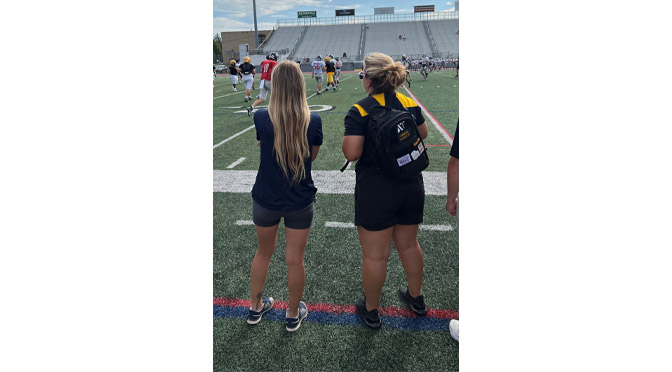|
|
National news is reporting that at least three student athlete football players have died on the field in the past month due to an unknown condition or catastrophic injury.
Youth sports offer countless benefits, from physical fitness to the development of teamwork and leadership skills. However, the dynamic nature of sports also presents the risk of emergencies, such as sudden injuries, exacerbation of pre-existing known or unknown medical conditions or environmental hazards. In these critical moments, having a well-prepared and practiced Emergency Action Plan (EAP) is essential to ensure the safety and well-being of young athletes.
“The National Athletic Trainer’s Association recently published a position statement on emergency action plan development and implementation in sport, updating current best practices from an original publication in 2002,” noted Brian Wiese, St. Luke’s Sports Medicine program manager.
St. Luke’s Sports Medicine is the largest provider of sports medicine services throughout northeastern Pennsylvania, offering the most comprehensive and advanced treatment for athletic injuries. Caring for thousands of student athletes at dozens of schools throughout the region, St. Luke’s Sports Medicine is the official medical provider of the Pennsylvania Interscholastic Athletic Association (PIAA) State Championships, the official sports medicine provider for District XI, the official sports medicine provider for the Lehigh Valley Youth Phantoms and a partner of the National Football Foundation (NFF).
“Emergency action planning often falls on the shoulders of an athletic trainer,” Wiese said. “However, to gain widespread utilization and implementation, we must start to get acceptance, engagement and adoption from organizational leadership. We need all stakeholders to become vested and involved for there to be true success with implementation.”
An Emergency Action Plan (EAP) is a detailed, systematic protocol designed to guide coaches, staff and volunteers in responding effectively to emergencies. Whether it’s a serious injury, a medical condition like an asthma attack or an environmental threat such as extreme weather, an EAP outlines the steps to be taken to provide immediate care, manage the situation, and ensure the safety of all participants.
EAPs are not one-size-fits-all; they must be tailored to the specific needs of the sport, the age and ability levels of the athletes, the facilities being used, and the potential risks associated with the activity. An effective EAP is comprehensive, regularly updated and practiced by all relevant personnel.
Key components of a youth sports EAP include:
Clear Roles and Responsibilities
An effective EAP clearly defines the roles and responsibilities of all individuals involved. This includes coaches, assistant coaches, medical personnel (if available), and even parents. Each person should know their specific duties during an emergency. For example, one person might be responsible for administering first aid, another for calling emergency services and another for guiding emergency responders to the site.
Having predefined roles ensures that everyone knows what to do, reducing confusion and enabling a swift response. In situations where trained medical personnel are not available, coaches and volunteers should be trained in basic first aid and CPR, ensuring they can provide immediate care until professional help arrives.
Communication Protocols
Effective communication is vital in an emergency. An EAP should include a communication plan that details how to contact emergency services, inform parents, and coordinate with facility staff or event organizers. It’s important to have a list of emergency contact numbers readily available and to ensure that all staff members know how to use any communication devices, such as radios or phones, in case of an emergency.
The EAP should also outline how to communicate with the athletes themselves, providing reassurance and instructions while keeping them calm and safe. In the case of a large-scale emergency, such as a natural disaster, communication protocols should extend to coordinating with local authorities.
Emergency Equipment and Supplies
Having the right equipment on hand can make all the difference in an emergency. An EAP should specify the location and contents of first aid kits, automated external defibrillators (AEDs), and any sport-specific safety gear, such as splints or ice packs. Coaches and staff should be trained in the use of this equipment, and it should be regularly checked to ensure it is in good working order.
An EAP is only effective if it is practiced regularly and reviewed frequently. Coaches, staff and volunteers should participate in drills that simulate different emergency scenarios, allowing them to become familiar with their roles and the procedures. Regular reviews of the EAP ensure that it remains up to date with any changes in personnel, facilities, or equipment.
“Developing and implementing emergency action plans have no cost barriers, it just requires the time, attention, and a little hard work from a collaborative group of stakeholders,” says Wiese. “We often hear about money and budgets being a limiting factor to purchasing or implementing an initiative to better prepare for the worst-case scenario, but this is simply not the case with emergency action planning.
Youth sports emergency action plans are critical for ensuring the safety and well-being of young athletes. By clearly defining roles, establishing communication protocols, ensuring the availability of emergency equipment, and accounting for venue-specific considerations, an EAP provides a structured and effective response to emergencies. Regular practice and review of the EAP are essential to ensure that all involved are prepared to act swiftly and confidently in critical situations. By prioritizing safety through comprehensive EAPs, we can protect our young athletes and allow them to enjoy the benefits of sports with peace of mind.
About St. Luke’s
Founded in 1872, St. Luke’s University Health Network (SLUHN) is a fully integrated, regional, non-profit network of more than 20,000 employees providing services at 15 campuses and 350+ outpatient sites. With annual net revenue of $3.4 billion, the Network’s service area includes 11 counties in two states: Lehigh, Northampton, Berks, Bucks, Carbon, Montgomery, Monroe, Schuylkill and Luzerne counties in Pennsylvania and Warren and Hunterdon counties in New Jersey. St. Luke’s hospitals operate the largest network of trauma centers in Pennsylvania, with the Bethlehem Campus being home to St. Luke’s Children’s Hospital.
Dedicated to advancing medical education, St. Luke’s is the preeminent teaching hospital in central-eastern Pennsylvania. In partnership with Temple University, the Network established the Lehigh Valley’s first and only four-year medical school campus. It also operates the nation’s oldest School of Nursing, established in 1884, and 52 fully accredited graduate medical educational programs with more than 500 residents and fellows. In 2022, St. Luke’s, a member of the Children’s Hospital Association, opened the Lehigh Valley’s first and only free-standing facility dedicated entirely to kids.
SLUHN is the only Lehigh Valley-based health care system to earn Medicare’s five-star ratings (the highest) for quality, efficiency and patient satisfaction. It is both a Leapfrog Group and Healthgrades Top Hospital and a Newsweek World’s Best Hospital. The Network’s flagship University Hospital has earned the 100 Top Major Teaching Hospital designation from Fortune/PINC AI 10 years in a row, including in 2023 when it was identified as THE #4 TEACHING HOSPITAL IN THE COUNTRY. In 2021, St. Luke’s was identified as one of the 15 Top Health Systems nationally. Utilizing the Epic electronic medical record (EMR) system for both inpatient and outpatient services, the Network is a multi-year recipient of the Most Wired award recognizing the breadth of the SLUHN’s information technology applications such as telehealth, online scheduling and online pricing information. The Network is also recognized as one of the state’s lowest-cost providers.
Information provided to TVL by:
Sam Kennedy







